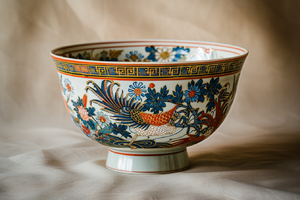كو إيماري
Ko-Imari

يشير مصطلح "كو-إيماري" (حرفيًا "إيماري القديمة") إلى أقدم وأشهر طراز من خزف إماري الياباني، والذي أُنتج بشكل رئيسي خلال القرن السابع عشر. صُنعت هذه الخزفيات في مدينة أريتا وصُدّرت من ميناء إماري القريب، الذي اشتق منه اسمها. تتميز كو-إيماري بشكل خاص بأسلوبها الزخرفي الديناميكي وأهميتها التاريخية في تجارة الخزف العالمية المبكرة.
الخلفية التاريخية
ظهرت أواني كو-إماري في أوائل عصر إيدو، حوالي أربعينيات القرن السابع عشر، عقب اكتشاف طين البورسلين في منطقة أريتا. وتأثر الخزافون اليابانيون المحليون في البداية بالبورسلين الصيني الأزرق والأبيض، فبدأوا في تطوير هويتهم الأسلوبية الخاصة. ومع تراجع صادرات الصين من البورسلين بعد سقوط سلالة مينغ، بدأ البورسلين الياباني يسد الفجوة في الأسواق العالمية، وخاصةً من خلال التجارة مع شركة الهند الشرقية الهولندية.
الميزات الرئيسية
تشمل الصفات المميزة لـ Ko-Imari ما يلي:
تصاميم جريئة وملونة، تجمع عادةً بين طبقة طلاء زرقاء كوبالتية تحت التزجيج ومينا طلاء فوق التزجيج بألوان الأحمر والأخضر والذهبي.
زخارف كثيفة ومتناسقة تغطي كامل السطح تقريبًا، وغالبًا ما توصف بأنها غنية بالزخارف أو حتى فاخرة.
زخارف مثل الأقحوان والفاوانيا والعنقاء والتنين والأمواج أو السحب المنمقة.
جسم خزفي سميك مقارنةً بالقطع الأحدث والأكثر رقيًا.
لم تكن أواني كو-إماري مخصصة للاستخدام المنزلي فقط، بل صُممت العديد منها لتناسب الأذواق الأوروبية، بما في ذلك الأطباق الكبيرة والمزهريات وزخارف العرض.
Export and European Reception
Ko-Imari ware was exported in large quantities throughout the 17th and early 18th centuries. It became a fashionable luxury item among European elites. In palaces and aristocratic homes across Europe, Ko-Imari porcelain adorned mantelpieces, cabinets, and tables. European porcelain manufacturers, particularly in Meissen and Chantilly, began producing their own versions inspired by Ko-Imari designs.
Evolution and Transition
By the early 18th century, the style of Imari ware began to evolve. Japanese potters developed more refined techniques, and new styles such as Nabeshima ware emerged, focusing on elegance and restraint. The term Ko-Imari is now used to specifically distinguish these early exported works from later domestic or revival pieces.
Legacy
Ko-Imari remains highly valued by collectors and museums worldwide. It is considered a symbol of Japan’s early contribution to global ceramics and a masterwork of Edo-period craftsmanship. The vivid designs and technical achievements of Ko-Imari continue to inspire both traditional and contemporary Japanese ceramic artists.
Relationship to Imari Ware
While all Ko-Imari ware is part of the broader category of Imari ware, not all Imari ware is considered Ko-Imari. The distinction lies primarily in the age, style, and purpose. Ko-Imari specifically refers to the earliest period, characterized by its dynamic energy, export orientation, and richly decorated surfaces.
